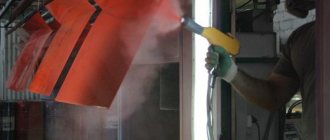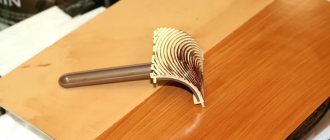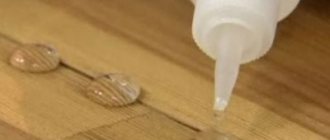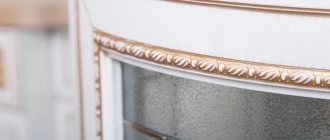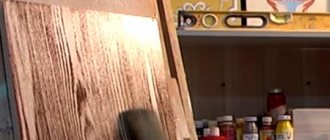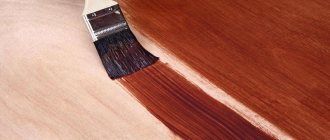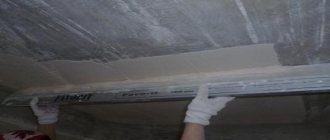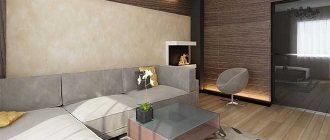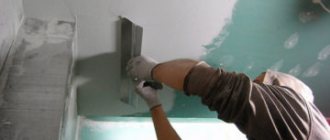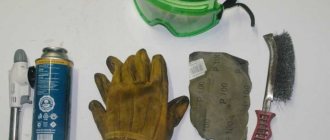Wood-polymer composite (WPC) is a mixture of two main materials - various wood waste and a polymer binder, which also often consists of plastic waste.
Due to the fact that one of the components is wood, and the other is a thick, but still liquid, such mixtures are often called liquid wood.
At enterprises, various finishing and structural materials are made from WPC, which are then used not only in construction, but also in such areas as automotive construction, aircraft construction and many others.
Despite the fact that the process of industrial production of this material requires heat treatment, wood-polymer composite can be made at home , and its characteristics are not much inferior to industrial designs.
Next we will tell you:
- what materials are needed for making liquid wood yourself;
- how to work with polymer mass at home;
- what can be made from it;
- how to change the color of the finished product;
- how to increase the strength and rigidity of the finished product;
- Can it be used as a repair material?
What can WPC be made from?
At home, you have to use materials that you can buy in regular or online stores, or you can also make them yourself.
Any wood waste is well suited as a filler , but the larger its size, the more polymer binder will have to be used.
You will find more detailed information about wood waste in these articles:
- Sawdust;
- Types of chips;
- Woodchips.
In addition, the larger the filler, the more difficult it is to fill the form for filling with liquid wood, therefore, to work with mixtures based on large wood waste (sawdust or shavings), it is necessary to use additional equipment, such as presses or vibrating tables.
On the other hand, a larger filler better reinforces the finished product , making it more rigid and durable.
Various substances and materials with different properties can be used as polymer binders, making each of them better suited for a particular situation.
Here are the most popular polymer fillers :
- PVA glue;
- acrylic adhesives, paints and varnishes;
- epoxy resin;
- polyester resin;
- nitrocellulose adhesives, paints and varnishes;
- homemade adhesives based on various solvents.
PVA
This glue is safe both in liquid and frozen states, because it does not emit toxic substances and does not burn well even in fire conditions.
The glue has high adhesion to any wood waste, and after hardening it turns into a fairly durable monolithic piece.
It can be bought at any construction or hardware store, and it is relatively inexpensive (40–160 rubles per 1 kg).
If the contents of the jar turn out to be too thick, then the PVA can be diluted with ordinary clean water. The disadvantages include poor transparency of the hardened glue, so it is not suitable for all jobs.
Acrylic adhesives, paints and varnishes
These materials are in many ways identical to PVA. They are also safe in a liquid state, but are more flammable when frozen . All acrylic binders easily envelop any wood waste, and thanks to their water base, they penetrate even into the top layer of wood.
The cost of these materials is comparable to the price of PVA glue, so they can be classified as the cheapest binders.
Like the previous glue, these materials have very low transparency after hardening, so they cannot be used for all jobs.
The color of these materials, as well as PVA, can be changed with water-soluble colors , which are sold in any hardware or hardware store.
Epoxy resin
Epoxy resin (epoxy) is a rather difficult material to use, because it consists of the resin itself and a hardener. In addition, the finished resin is a thick gel that is difficult to mix with any filler, and liquefaction by heating sharply reduces the polymerization time.
The main advantage of epoxy resin is its beautiful color and high transparency after hardening.
In addition, the color of the resin can be changed using paste from regular pens or oil/nitrocellulose paints. Its cost is quite high - 1 kg will cost 1.5–3 thousand rubles .
Due to the high toxicity of the resin and hardener, you can only work with them in well-ventilated areas.
There are also water-soluble epoxy resins. They are easier to work with and also noticeably cheaper, but after hardening they turn into an opaque material. In addition, it is easier to make them more liquid and mobile using various plasticizers, which makes it easier to mix the resin with crushed wood waste.
The disadvantage of water-soluble epoxy resins is slightly less adhesion to wood . To harden, they also need a hardener, which activates chemical processes leading to polymerization of the mixture.
Polyester resin
There are 2 main types of polyester resins, distinguished by the original product, that is, obtained from :
- oil;
- vegetable resins.
The former are more liquid , so they are easier to use, but they are extremely toxic , so you can only work with them in well-ventilated areas, wearing protective clothing (goggles, respirator, rubber gloves).
The latter much less toxic (although working with them also requires a ventilated room), and are also thicker, which makes them more difficult to mix with filler and pour into molds.
Both types of resins, after hardening, form a solid polymer, much inferior in transparency to epoxy, but superior in this parameter to most other materials.
A significant disadvantage of both types of this material is
large shrinkage , because first the excess solvent evaporates, then the polymerization reaction begins.
Moreover, the rate of polymerization directly depends not only on temperature, but also on the type/amount of hardener, without which the resin, having lost most of the solvent, will turn into a thick jelly.
The average cost of both types of this material is 200 rubles per 1 liter .
Nitrocellulose adhesives, paints and varnishes
These materials are highly toxic and flammable in both liquid and solid states, so they cannot be used for the manufacture of parts that will be located in high temperature zones.
In addition, all nitrocellulose materials are characterized by the highest shrinkage , because hardening occurs not due to polymerization, but due to evaporation of the solvent.
After hardening, these substances turn into a hard and durable, almost opaque material.
You can make glue, paint or varnish more liquid using a solvent, but you must use exactly the substance indicated on the label. The average cost of such materials is 200 rubles per 1 liter.
Homemade adhesives based on various solvents
In most cases, such adhesives are extremely toxic and very flammable , so you should only use them if you have extensive experience working with such substances. Like nitrocellulose liquids, such adhesives do not polymerize, but dry , turning into a solid monolithic material.
Advantages over competitors
The widespread use of liquid wood is not an accident or a desire to stand out, although this is often important.
It’s just that everyone today wants, by paying a certain amount, to receive a product or product that meets certain requirements. In our case, this is:
Environmental cleanliness, which has received great attention lately. As you can see for yourself, there is nothing foul-smelling or evaporating in the composition - everything is pure and natural. As we have already mentioned, surfaces made from our material are not afraid of mechanical damage, and do not even require additional painting
They look perfect even without “makeup” and are not afraid of the sun’s ultraviolet radiation. In this case, salts, acids, and other substances that adversely affect most building materials are also not dangerous. Separately, I would like to talk about humidity, which destroys wood-based materials, including. In this case, increased humidity does not harm at all, and the products can withstand any temperature without swelling or drying out. Easy installation and maintenance. Liquid wood, like its ancestor, is perfectly processed using ordinary tools. Installation is easy and even effortless, while maintenance often comes down to simply wiping with a damp cloth or sponge.
Liquid wood in the interior of a house is something unimaginable!
We can praise liquid wood for a long time, but there are many building materials that deserve attention. Some of them may be stronger, others, and this is quite understandable, look much more ideal, but in our case you will always get: strength, durability and environmental impeccability. You may not know that liquid wallpaper is also practiced, which also has a number of advantages.
The principle of working with a polymer mixture
The principle of working with liquid wood is the same regardless of the type of polymer and consists of the steps described below.
Preparing the mixture
The exact proportions of fillers and other components for each type of wood waste and binders can only be determined experimentally .
After all, everything depends not only on the type of binder and the degree of grinding of wood waste, but also on:
- polymer grades;
- compliance of the hardener (often the polymer and hardener are purchased separately);
- purpose of the finished product;
- mixing method;
- adding plasticizers and other substances.
It is necessary to mix the ingredients of liquid wood in a container made of a material that is chemically neutral with respect to all substances.
The main condition when working with such compositions is to accurately determine the volume of the finished mixture , which you will have time to produce before polymerization begins, because as soon as this process begins, any impact on the mixture will lead to a decrease in its strength after hardening.
First, you need to make small portions (100–200 ml of the finished mixture) in order to work out the sequence of actions and determine the optimal proportions of materials.
For stirring, use a spatula made of a chemically inert material, in most cases it is metal, wood or plastic. It is enough to mix the ingredients for 1–3 minutes to obtain a composition suitable for further use.
An external criterion for the readiness of a composition is its homogeneity - as soon as all the material has become one color, the mixture can be considered ready.
Preparing the form
The choice of form (matrix) depends on what product you want to obtain in the end. This can be either a purchased or homemade matrix of the desired shape, made from various materials. Moreover, the form can even be made from a material that is chemically active in relation to the solvent.
But in this case, it will need to either be covered with a chemically neutral film, or covered with a suitable protective composition, for example, silicone spray or soap solution.
Molds made of silicone and other soft materials can only be used for pouring without compaction.
Therefore, most often they are used to make various small shaped parts that do not require high strength.
If you need to make something durable, for example, a siding board or laminate flooring, then you will need a metal mold that can withstand pressure or vibration.
To make parquet, laminate and other similar parts, it is necessary to use a collapsible mold , because in addition to a pattern or a flat surface on the front side, they also have locks on the ends. After the mixture is poured and hardened, the side walls of the mold are removed, then the casting is disconnected from the front wall.
Pouring and sealing
If possible, fill the entire mold with liquid wood in one pour, paying special attention to corners and uneven areas. Or, if this is not possible, layer by layer, as new batches of the composition are prepared.
The disadvantage of this approach is obvious: the material at the boundaries of the layers will have less strength , because the chemical reactions leading to its polymerization will proceed unevenly. This is especially important when producing parts with high strength values, such as laminate.
In such cases, several compatible batches of solution are prepared and the most transparent is poured first, then paper with a pattern is placed on it, after which the remaining layers are poured.
In the liquid state, the polymer mixture will saturate the paper, due to which the layers will connect and the polymerization process will proceed evenly.
Vibration and pressure are used to compact the material into molds . In the first case, a vibrating table is used, which is used in the production of paving slabs or cinder blocks; in the second, a press and a plate corresponding to the shape are needed.
At home, you can use any screw or hydraulic press, for example, designed to replace silent blocks on cars.
Sometimes it becomes necessary to increase the rigidity of the finished product and its torsional or fracture strength.
In this case, the first part of the finished mass is first poured, then metal, glass or carbon fiber reinforcement is laid and the second layer is poured, after which it is compacted first by vibration, then by pressure. Thanks to this, the polymer mixture completely covers the reinforcement and, after hardening, forms a single whole with it.
When working with epoxy resin, before pouring, the mixture is heated to a temperature of 40–60 degrees to make it more mobile, after which it is poured and compacted by vibration. The lifetime of such a mixture is 10–20 minutes, so you need to work with it quickly, avoiding unnecessary movements and unnecessary downtime.
Drying and polymerization
Each polymer requires special conditions for high-quality polymerization or hardening, so you must read the instructions on the packaging with the polymer component in advance. In addition, it is advisable to collect detailed information from various forums where users discuss working with certain substances.
The most unpretentious in this regard are compositions based on PVA, acrylic and epoxy resin, because they only require positive temperatures (15–25 degrees) for polymerization.
Compositions based on polyester resins, especially those made from petroleum, require, in addition to a positive temperature, good ventilation, otherwise the air in the room will be filled with volatile substances and become not only toxic, but also explosive.
Nitrocellulose liquids , as well as adhesives based on dichloroethane or ether, harden well at temperatures above zero degrees, but during the hardening process they release extremely toxic and flammable substances . Therefore, mixtures based on them should dry in a room with very good ventilation.
Extract from form
If all previous operations, including preparing the mold, are performed correctly, then a small force is enough for the matrix to separate from the frozen or polymerized part.
To remove a frozen casting from a soft or flexible matrix, the mold along the edges is gently bent away from the part to separate them.
This operation is carried out along the entire perimeter, then the back side of the casting is placed on a table or palm and the matrix is removed from it, like a skin or a stocking. If the polymer mixture was poured into a silicone volumetric mold , the depth of which is equal to or greater than half the width, then such a matrix must be turned inside out .
You can not turn it all the way out, but just enough to grab the casting with your fingers, then hold the mold with one hand and pull out the product with the other, slightly rocking it in different directions.
To remove the casting from a rigid flat mold, the matrix must be turned over, holding the casting and placed on the table, then lightly tap the bottom with your fingers so that the vibration causes the finished product to move away from the matrix.
Post-processing
A mixture of wood waste with any of the suitable polymers, after hardening, turns into a solid material suitable for subsequent processing.
Using a file and sandpaper, protruding casting defects are removed from the finished product.
If necessary, finished casting:
- engrave, creating the desired design on it;
- polished to give a mirror or matte shine;
- milled;
- drill;
- cut threads;
- sawed into pieces.
In addition to mechanical processing, finished parts can be glued together, and screws or self-tapping screws can be screwed into them.
Turning metal or plastic into wood is easy
In the photo - KAOWA SEMENTOL - “liquid wood”
On the Internet you will find many videos in which professional artists, using special brushes, foam swabs and other means, recreate the texture of wood on various objects. After varnishing, objects finished in this way are practically indistinguishable from their wooden counterparts.
Stock up on the necessary tools, patience and try to do something like this. Unfortunately, you most likely will not be able to draw the texture of wood by hand. But don’t despair, there is a way out - this is a special paint that imitates the structure of wood.
For example, in some specialized stores you will find paints and varnishes presented by the KAOWA SEMENTOL brand. On cans of these products you will see such designations as “mahogany paint” or oak, ash, teak, etc.
That is, these paints and varnishes make it possible not only to imitate the arrangement of wood fibers on certain surfaces, but also to reproduce the texture of valuable or exotic wood species. This advantage is especially important when decorating furniture and other elements of the surroundings.
Scope of application
The photo shows a variety of paint colors that imitate wood texture
Special paints and varnishes, sold as liquid wood paint, are intended for treating various surfaces with high and medium density. These coatings can be used both for interior finishing work indoors and for exterior finishing.
The paint can be applied with equal success to wood, plastic, metal, ceramic, glass and other substrates with a matte, smooth and glossy surface. Specialized paints to imitate wood texture do not contain wood-based fillers and are therefore resistant to the negative effects of environmental factors.
As already mentioned, the use of special compounds is important when decorating furniture and other elements in the interior with your own hands.
These paints are widely used in workshops involved in improving car interiors. Thanks to special paints and varnishes, unpresentable plastic dashboards, lids of various boxes and other surfaces in the car can be made “wooden”.
Despite the fact that the price of paints and varnishes that imitate the texture of wood is several times higher than the cost of traditional enamels, this method is still more affordable than paying for the services of a professional artist.
Features of applying “liquid wood”
The use of special paints and varnishes is no more difficult than ordinary painting of wood. But there is one condition: you must use the right tool: a hard, flat brush based on natural bristles.
The length of the bristles determines how pronounced the texture of the wood will be. That is, if you need the fibers to be well drawn, use a brush with short bristles. The longer the bristles, the more poorly defined the texture will be.
The paint is applied directly from the can without special preparation and without the use of solvents. It is necessary to decide in advance on the required color, since it will not be possible to change the tone or color of the paint during application.
It is necessary to prepare the surface before decorating in the same way as before applying any paints based on organic solvents. That is, the base is cleaned of unevenness and dirt, primed and only then painted.
If a glossy finish is being decorated, it should be matted with zero sandpaper to ensure maximum adhesion.
Forming veins with a hard brush
The paint is applied in long stripes from one edge of the product to the other. You should not rub the applied layer, as is done with conventional coatings, as the texture of the imitation wood fibers will be damaged. A shiny film appears literally 15 minutes after application, and complete drying occurs in 1-3 hours, depending on temperature and humidity.
According to people who have used KAOWA SEMENTOL in accordance with the instructions indicated, the finished coating is an order of magnitude superior in quality and similarity to cut wood.
What can you make from a wood-polymer composite yourself?
This material combines the best qualities of wood and polymer, and such characteristics as :
- strength, including fracture strength;
- hardness;
- rigidity;
- color;
- transparency;
- smell,
can be adjusted by changing the percentage of the main components and in other ways. All this allows you to create material that is well suited for certain jobs.
In addition, due to the fact that in the initial state the mixture is a thick liquid, it can be used to cast parts that are difficult to make in any other way. For example, you can make a gypsum matrix from some three-dimensional image and make copies of it from WPC.
You can make parts of the box body decorated with unusual three-dimensional patterns, and put a picture on a paper base under the thin outer layer of transparent polymer.
As a result, such a box will combine three-dimensional patterns, including engraving and internal design. This opens up a huge scope for creativity, because from WPC you can make :
- finishing elements for walls and floors, including mosaic paintings;
- caskets;
- frames for postcards or photographs;
- tabletops, including those decorated with patterns;
- cutting boards;
- housings for homemade equipment;
- figurines;
- three-dimensional images, including stylized wood carvings.
Areas of use of liquid wood
The scope of application of wood polymer is gradually expanding. It is used in the production of the following products.
- Double-layer parquet. The size of such tiles is 3x3 meters, thickness from 25 to 55 mm. The first layer is a polymer, and the second is a wooden base, which is attached to the substrate with small screws. This type of parquet is used to cover a garden plot and an open terrace.
- Siding for the exterior of a house.
- Terrace board or decking. It is suitable for floors and car parking, and has found application in lining marinas, ship decks and piers.
This innovative building material is used in the design of residential and public premises and construction. This coating will not wear off, crack, chip, or mold from rain and snow. Wood-plastic can be used to make blanks for furniture that can withstand heavy loads.
Wood in combination with plastic goes well with brickwork, plasterboard and concrete.
Advantages and disadvantages of products made from homemade WPC
The main disadvantage of homemade products made from wood-polymer composite compared to factory products made from WPC or plastic is several times lower compressive and fracture strength .
This is caused by the lower density and homogeneity of the finished material, because at enterprises the components are mixed using special equipment.
In addition, the main ingredients are first mixed in powder form, then heated until the polymer melts and the semi-liquid mass is mixed. Another reason for the difference in strength is extrusion, that is, forcing the molten mixture through a die, which ensures maximum compaction of the material in the finished product.
In addition, compliance with the proportions of the mixture and the order of actions at all stages of production plays an important role .
In production, this is monitored automatically, and anyone who is trying to make something from a wood-polymer composite at home is forced to determine the proportions “by eye”, and also independently monitor compliance with the procedure.
The situation is the same with plastics, because products from them are produced by extrusion. Despite their lower strength, homemade products have significant advantages , the main one of which is low price .
After all, the most popular polymers, that is, PVA or acrylic liquids, are inexpensive, and wood waste is used as a filler, the cost of which you can read here, as well as in this article.
If wood flour is needed to make crafts from WPC, then it can be bought in a store at the same price as sawdust or obtained from small wood waste using a coffee grinder.
However, the maximum advantage if there are no analogues made from other materials .
In this case, even the use of expensive resins and independent grinding of wood into a small fraction is not a significant drawback, because the result of all this will be the appearance of a thing, the analogue of which can only be made by hand.
Pros and cons of wood plastic
The unconditional advantages of polymer-composite wood include:
- moisture and heat resistance
- antibacterial components that prevent the appearance of rot and mold
- resistance to mechanical stress
- ease of operation
- no need for additional painting or varnishing
- ease of care and cleaning - WPC coating is easy to clean using usual methods, and even aggressive household chemicals will not harm the material
- variety of colors and shapes
- long service life - from 25 years
- can be recycled
- has all the qualities of natural wood at a significantly lower cost
The disadvantages include the need for additional ventilation and compliance with temperature and humidity conditions - these indicators should not be high.
How to make a craft from this material at home?
In this section we will talk about how to make a beautiful seat for a stool yourself from epoxy resin and scraps of branches or large wood chips. You can also use sawdust, shavings or flour instead of filler, and you can use a printed pattern to create texture.
If you don't have epoxy resin, you can use any other polymer by adjusting the composition of the components and hardening conditions.
Where other materials can be used instead of the specified materials, we will provide brief explanations that will help you better understand the procedure for working with different materials.
Matrix preparation
Buy or make your own matrix of the desired shape and size . It can be round, square, triangular or whatever you like.
The main condition is that the depth of the matrix must exceed 4 cm, thanks to this the seat will be strong enough to support the weight of even a very large person. In addition, with a smaller thickness it will be difficult to attach the stool legs to the lid.
Preparation of wood material
Cut debarked branches 1–6 cm thick into pieces whose length is 1 cm less than the depth of the matrix.
It is advisable to use branches of different varieties , especially those whose wood differs in color.
If you use wood chips, ventilate them well, tossing them in small portions to remove dust.
The main condition when choosing wood materials is a humidity of 5–10%, the lower the better. After all, excess moisture will begin to destroy the wood even without air access and over time the appearance of the cuts will change.
Determining the required volume of resin and hardener
Usually, to do this, it is enough to calculate the volume of the matrix and divide it by 2 or 3 (depending on the amount of wood filler). It is advisable to increase the resulting value by 10–15%; the excess resin will have to be thrown away, but there will definitely not be a shortage of resin, due to which the entire work will have to be redone.
Preparing the mixing container
Its volume should be 3–5 times greater than the volume of all ingredients.
A plastic paint bucket works well as such a container , because it is wide enough and made of a material that is chemically inert to epoxy.
The same container can be used when working with PVA or acrylic compounds, however, when mixing polyester resins or any mixtures based on acetone or toluene, only metal, ceramic or glass containers should be used.
Preparing the mixture
Pour the required amount of resin and solvent into the mixing container, then mix them with smooth movements.
If necessary, divide the mixture into several parts, this will allow you to use both the most transparent solution and compositions with dyes or fillers .
First add dye to the finished resin, then mix, add wood filler to it and mix again.
Preparing the drawing
Print it using a printer on non-waxed paper. You cannot use wax paper, because the resin impregnates it much worse. Trim the drawing so that its dimensions are 1–3 cm smaller than the size of the form. If you do not insert the drawing, then you can skip this point.
Important steps before pouring
Spray a wooden, metal or plaster mold with silicone spray. If the matrix is made of polyethylene, polypropylene or polyvinyl chloride, then it is enough to lubricate it with a thick soap solution, and the thickness of the lubricant should be minimal .
Then install the matrix on a flat horizontal surface (it is advisable to first check it with a level). Also place all containers with ready-made mixtures in a water bath and heat to a temperature of 35–40 degrees, this will make the resin more liquid, but will shorten the time before polymerization begins.
Pouring the mixture into the matrix
Pour the first layer of resin into the mold, its thickness is 5-10 mm, this will be the top part of the seat.
If the matrix design provides for the upper part of the seat on the other side , then this operation will need to be performed in the same way, but after pouring the main layers.
Then place patterned paper on it or install cuttings of branches, pressing them down a little. If you divide the mold into sections using plastic partitions, then each compartment can be filled with resin of its own color and the partitions can be removed immediately after pouring. Some of the resin at the edges of the areas will mix and provide a relatively smooth color change.
In the same way, you can make a not too complex drawing. The main thing is to use the same resin and complete all operations before polymerization begins .
You can also make an inscription, but you will first have to make a partition of a suitable shape. After the resin hardens, this inscription will be an integral part of the seat, so it will not go away even after several polishings.
If you are making the seat only from a mixture of resin and wood filler, then you can skip this point.
When using cuttings of branches, it is necessary to take into account that the density of the resin is noticeably higher, so they will try to float .
To avoid this, you can wait until the bottom layer of resin begins to polymerize, until its state becomes jelly-like, and then pour in the main mass (accordingly, you will need to prepare the main mass of the resin after the start of the polymerization process).
It is also possible, without waiting for the first layer of resin to polymerize, pour the second layer, then cover it with polyethylene and apply it with an even flat weight, the size of which corresponds to the size of the mold, and the weight itself must be placed strictly level.
Pour the bulk of the heated mixture into the mold, then use a plastic spatula to compact the resin over the entire area, paying special attention to the edges. Avoid the appearance of bubbles; if they arise, deflate them immediately.
If you are pouring a mixture of resin and wood filler, then compact it more thoroughly with a spatula, pushing it from top to bottom in increments of 2–4 cm.
Check the top edge of the fill using a level, and if necessary, level it using a spatula .
Product polymerization
Leave the mold filled with the mixture for a day in a room with a temperature of +20 degrees so that most of the polymerization process takes place.
Take out the craft and leave it there for another 72 hours so that the polymerization process is completely completed.
The polymerization time of other compositions must be found on their labels.
Post-processing
After the resin has completely polymerized, sand the seat to remove any defects in the fill. If the thickness of the layer being removed is thicker than 0.1 mm, then it is better to use a grinder. If desired, the seat can be processed with a hand milling cutter or engraved on it.
Attach the seat to the stool. Ready.
Advantages and features
- wood shavings, sawdust, wood chips;
- from leaves;
- agricultural crop waste;
- from paper;
- peat;
- coal;
- from manure.
All of the above types of waste are natural, self-regenerating sources. Fuel briquettes made at home are distinguished by their environmental friendliness; they burn completely, while practically not producing smoke.
This fuel can perfectly warm a bathhouse or sauna; they flare up and begin to produce heat very quickly. They will be especially beneficial for people who like to cook on grills, because the fat that drips onto the fuel will not ignite.
The high density of briquettes gives them high resistance to fire hazards; they can be stored close to the boiler and do not waste time on transportation. As you can see, making briquettes from sawdust is the most convenient option for stoves or fireplaces, the same boilers that run on solid fuel.
It is important to know: the main advantages of natural fuel briquettes are their heat transfer, cleanliness and efficiency.
Unlike wood (firewood), fuel briquettes flare up faster and have less smoke, due to their lower humidity. When they burn, few sparks are released, the temperature will be constant. In addition, the briquettes have the correct shape, which makes their use and storage much more convenient.
The main disadvantages of briquettes are their ability to absorb moisture and be damaged by mechanical forces. It should be noted that the technology for producing briquettes at home will not be cheap, including the dryer, the press itself and the crushing apparatus.
Unless, of course, you have ready-made, already crushed raw materials. So you should not rush to purchase such equipment.
Using WPC for repairs
Homemade liquid wood can be used to repair any products from :
- wood of any species;
- chipboard;
- Fiberboard;
- MDF.
These may be small holes or chips, as well as small areas with visible rot or other diseases/pests.
The general principle of action is as follows :
- Select the most suitable binding material for the damaged surface. For wood, these are PVA, acrylic, epoxy and polyester resins; for other materials, PVA and acrylic-based liquids are better suited.
- Choose wood or color scheme that matches the color as much as possible. If the color does not differ, then it will be difficult to notice the repaired area.
- Clean the damaged area from deformed material, dust and dirt, then clean it with sandpaper and blow it with compressed air.
- When working with acrylic liquids or PVA, prime the damaged surface with an aqueous solution (50–80%) of the binder and leave for 1–2 hours for partial polymerization.
- Prepare wood pulp with the following ratio of ingredients: wood filler 70–80%, polymer 20–30%, color as necessary to obtain the desired color.
- Using a spatula, fill the damaged area with the prepared mixture, ensuring that it rises tenths of a mm above the surface.
- Remove all traces of the mixture, then wipe the surface with a damp cloth.
- After 24 hours, carefully sand the repaired area, first with fine, then very fine sandpaper.
- Sand the repaired and adjacent areas of the surface with zero-grade and velvet sandpaper, then (if necessary) coat with a varnish compatible with the existing varnish coating.
How to do without special paints
In the photo - hand-drawn texture
What to do if there are no special compounds to imitate the texture of wood in the nearest hardware stores, and most likely they will not appear, but it is necessary to decorate this or that surface?
In this case, you will have to awaken your creative potential and get to work.
- In order to paint a wooden surface, we will need acrylic paints and varnish on a similar base. We select paints of two colors: one is dark brown, the other is several tones lighter, closer to beige. We also use two types of flat brushes with stiff bristles. One brush with longer bristles and the other with shorter bristles.
- We prepare the surface. We clean it from dirt and dust and prime it if necessary.
- Apply dark paint as the first layer. The layer should be uniform and should be applied with a long-bristled brush. When the first layer is completely dry, you can begin applying the texture.
- Apply light paint in a second layer, also using a long-bristled brush.
In the photo - a tool for simulating wood using simple paints
Then we wait until the second layer begins to dry, take a short-bristled brush and draw one line across the coating from side to side. Veins resembling wood fibers will appear on the surface of the painted coating.
After the second coat of paint has completely dried, you can apply varnish.
How to imitate wood texture
The final color of the coating, which imitates the structure of wood, depends on the combined action of the first layer and the glaze layer. The first layer should be lighter, and it will be covered with a darker colored glaze. Suitable colors for the first coat are: natural sienna, iron oxide red, burnt sienna, burnt umber and beige tones. Good colors for glazes include: burnt umber, black, red iron oxide, burnt sienna. Since various stains are commonly used when working with wood, there is no need to repeat both the texture and color of all trees.
GLAZE FOR APPLICATION OF COATING IMITATING WOOD TEXTURE
Mix the following ingredients:
2 parts art acrylic paint or latex paint of desired sheen 1 part acrylic paint thickener
Apply the first coat of low-gloss latex enamel paint in the desired color, using strokes in the desired direction. Use a brush or sponge applicator; For large surfaces, use a paint roller. Let the paint dry
Mix glaze for decorative coating. Using an applicator with a sponge or an artificial bristle brush, apply an even layer of glaze over the first layer, working a small area at a time.
Run a rocker over the wet glaze to imitate wood grain; The rocker movement is done slowly to achieve the desired effect. Start from one corner; the work is performed in one continuous movement, while simultaneously with the movement of the rocker it rocks back and forth (photo above). As you can see from this picture, the position of the rocker determines what marks it leaves, imitating the texture of wood.
Repeat step 3 for subsequent rows, varying the distance between the oval marks. Use a dry cloth to wipe off any glaze that has accumulated on the instrument when necessary. On some rows, run the ridged or grooved side over the glaze instead of the rocker itself. This will change the appearance of the coating and imitate continuously stretching wood fibers.
Before the glaze is completely dry, brush the surface with a dry, soft natural bristle brush (7-10 cm wide). Brush lightly in the direction of the wood grain to soften the resulting finish. Clean your brush to remove excess glaze as needed. Let the glaze dry. If you prefer, you can apply a clear topcoat or clear acrylic spray sealer.
This is interesting: Features, advantages and disadvantages of mechanized putty
Types of forms of sawdust fuel briquettes
There are three forms obtained during the pressing process:
- Bricks are a form of RUF. Dimensions - 150x100x60 mm. Briquette humidity is up to 10%, density is about 1.2 g/cm3. The heat transfer is 4400 kcal/kg. These briquettes are low-ash and burn well. The package weighs 10 kilograms and contains 12 briquettes. They are produced by cold pressing and have a long shelf life of 3 years.
- Pencils – Pini Kay. Humidity, heat transfer and density indicators are similar to RUF. Dimensions -250x60 mm, with a hole with a diameter of 18-20 mm. They burn perfectly due to the presence of a hole in the middle of the briquette. Additional traction is created. Made by screw pressing at high temperatures. Shelf life up to five years.
- Cylinders - NESTRO. The moisture content of briquettes is from 8 to 10%. Density -1.0 g/cm3. Heat transfer 3900 kcal/kg. They have a length from 200 to 380 mm. The diameter of such a cylinder is 90 mm. Briquettes are made by pressing at medium pressure. They have a shelf life of only a year and the ash content is higher than the other two.
Sawdust briquettes RUF
Pini Kay and RUF burn best and last the longest.
Good for heating a house and lighting a bath. Cylinders are best used for heating non-residential premises due to their higher ash content. Date: September 25, 2021
Kaowa SEMENTOL
Called liquid wood, Kaowa SEMENTOL paint from the Spanish manufacturer PAIGUM imitates the texture of luxury wood. It is used both inside and outside. Used:
- for painting furniture;
- door and window coverings made of white plastic;
- household appliances;
- products made of plasterboard, metal, fiberboard, chipboard, wood, even if they have already been painted with a different paint or covered with enamel.
Its technical characteristics are as follows:
- dries in 2 hours;
- applied with a brush;
- consumed at the rate of 0.1 liters per 1 sq. m.
Recommendations for applying liquid wood paint yourself
In order for the surface to have a decent appearance after finishing, it is necessary to follow some recommendations:
- We prepare the surface, and if it is porous, then apply the base. The polished surface is treated with sandpaper.
- Mix the contents of the jar by shaking. We do not use any solvents or dyes.
- Apply the paint in a thick layer in one direction, but so that there are no smudges.
- Moving horizontally, distribute the applied paint evenly without additionally wetting the brush. Within 15 minutes the surface can be further adjusted, and then it dries.
- After drying, we coat the surface with varnish if it is exposed to atmospheric influences.
When does it make sense to produce fuel briquettes?
Mini-machine that makes briquettes.
Making fuel briquettes with your own hands, as shown in the video above, is only profitable when you have free sawdust. But even so, this event is not always advisable. For example, you have your own woodworking plant that needs to be heated. It’s just inconvenient to throw sawdust into the stove, and it doesn’t burn properly. In this case, it makes sense to buy a machine and stamp briquettes on it for your needs. The quality of the products will be acceptable, and you will save on heating costs. In this case, making briquettes manually is too troublesome, since a lot of energy is needed.
For heating a private home, homemade briquettes are also not the best option and here’s why:
- low quality due to the use of homemade presses;
- production requires a lot of time and effort.
This is if you don’t take into account the fact that you also need to make the press yourself. In addition, briquettes may not work out. An unpleasant surprise may await you after drying - the bricks sometimes simply fall apart. The point of self-production is when you want to make several cubes of briquettes to sometimes heat your dacha. But again, if you have your own sawdust and you are willing to spend several days on it.
